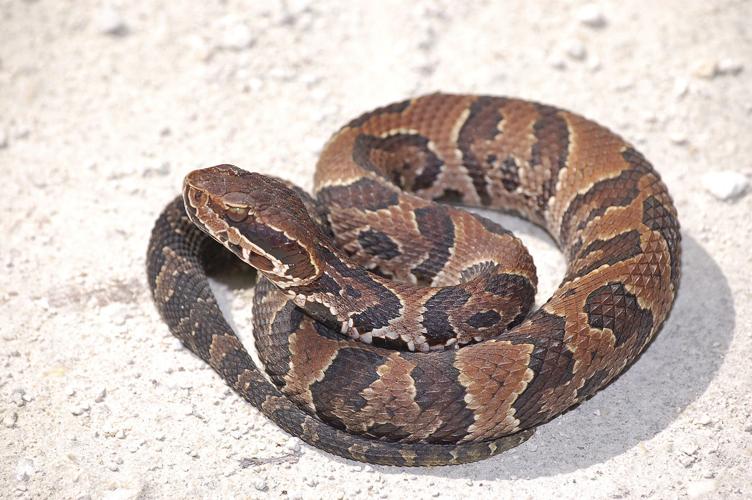“Is it a water moccasin?” I hear this question a lot when doing public education programs about snakes. The answer is always: “No. We do not have water moccasins in Nebraska.”
Many people do not know that several harmless northern water snakes are killed annually in Nebraska by people who believe those snakes are venomous water moccasins (also known as cottonmouths).
Water moccasin and cottonmouth are common names for the same snake. Cottonmouths are venomous and semi-aquatic, which means they can swim in the water, and still bask on land. Instead of the cottonmouth, Nebraska has the northern water snake, which, undoubtedly, looks similar to the cottonmouth in color, size and body shape. There is one huge difference, however: Northern water snakes are harmless.
Cottonmouths are large, heavy-bodied snakes. Juveniles usually are brightly patterned; adults are usually more of a solid black or brown color. These venomous snakes have a large triangular head with a dark band running through their eyes. Northern water snakes lack the triangular head and, instead, have a torpedo-shaped head. A signature defense mechanism for cottonmouths is to coil up, elevate their head off the ground and expose their open white mouth, hence the name “cottonmouth.” When disturbed or threatened, northern water snakes will flee, and usually slither into the water if approached by someone or something.
People are also reading…
Cottonmouths’ range is in the southern United States, with their most northern range reaching into south-central Missouri and extreme southeastern Kansas. These venomous snakes like warm, moist habitats, where the water does not freeze in the winter. As we all know, Nebraska has a winter season, so this is just one of many reasons why we do not have cottonmouths in our state.
Northern water snakes are fairly large, dark-colored snakes. They can be brownish, tan or grayish in color. Adult water snakes can even appear solid brown or black when out basking. On the sides and back, these snakes have square blotches that sometimes blend to form bands. The belly of this snake can range from orange to white to yellow with dark half-moon-shaped black edges.
The northern water snake can be found in a wide range of habitats in Nebraska, including streams, rivers, ponds, marshes and reservoirs. They are also very agile climbers and can often be seen basking in a tree or shrub overhanging the water. If you are lucky enough to see one swimming, they keep their heads down in the water, unlike a cottonmouth, which swims normally with its head elevated in the water.
People who believe they are venomous water moccasins kill many northern water snakes every year in Nebraska. Remember, we do not have those venomous species in our state; we just do not have the right climate. So, if you are ever tempted to ask the question: “Is it a water moccasin?” The answer will be a “no!”
Monica Macoubrie is a wildlife education assistant with the Nebraska Game and Parks Commission. Contact her at monica.macoubrie@nebraska.gov.


